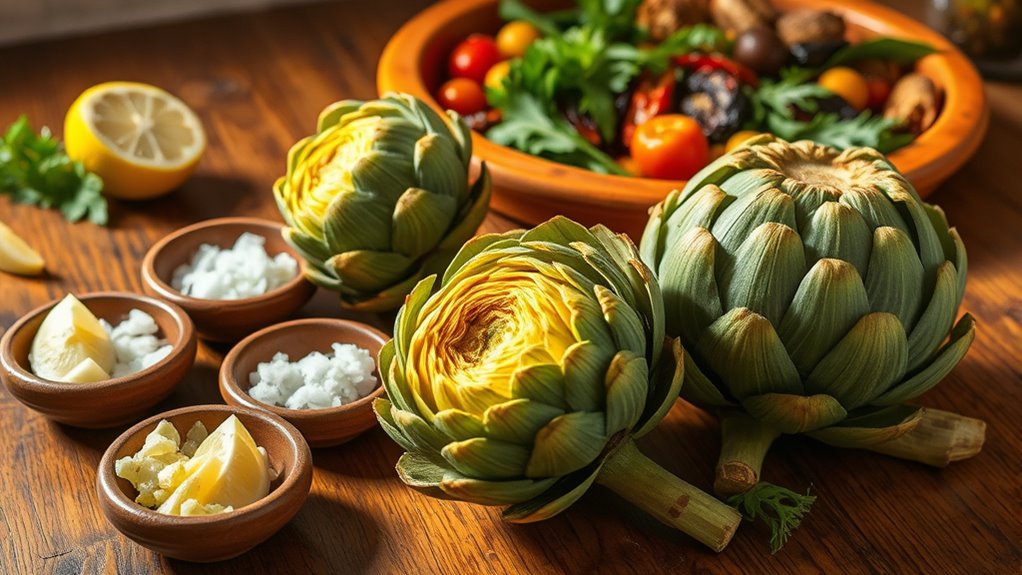To cook with artichokes in Sardinian recipes, start by choosing fresh, high-quality specimens and properly preparing them—trimming stems, removing tough outer leaves, and eliminating the fuzzy choke. Slice thinly or shave for salads, or cook by sautéing, boiling, or stewing to develop their delicate flavor. Enhance dishes with olive oil, lemon, herbs, and Sardinian ingredients. If you want to master authentic techniques, keep exploring for more tips and secrets.
Key Takeaways
- Select fresh, high-quality Spinoso sardo artichokes, trimming stems and removing tough outer leaves to prepare for cooking or raw dishes.
- Prevent browning by immediately rubbing cut surfaces with lemon juice and soaking slices in lemon water if needed.
- Use sautéing with garlic and herbs or boiling methods to cook artichokes evenly, enhancing their flavor and texture.
- Incorporate artichokes into Sardinian recipes like insalata, fregola, or rustic pies, combining them with local ingredients and seasonings.
- Finish dishes with extra virgin olive oil, lemon, and traditional Sardinian seasonings to preserve authenticity and vibrant flavors.
Selecting and Preparing Artichokes for Sardinian Dishes
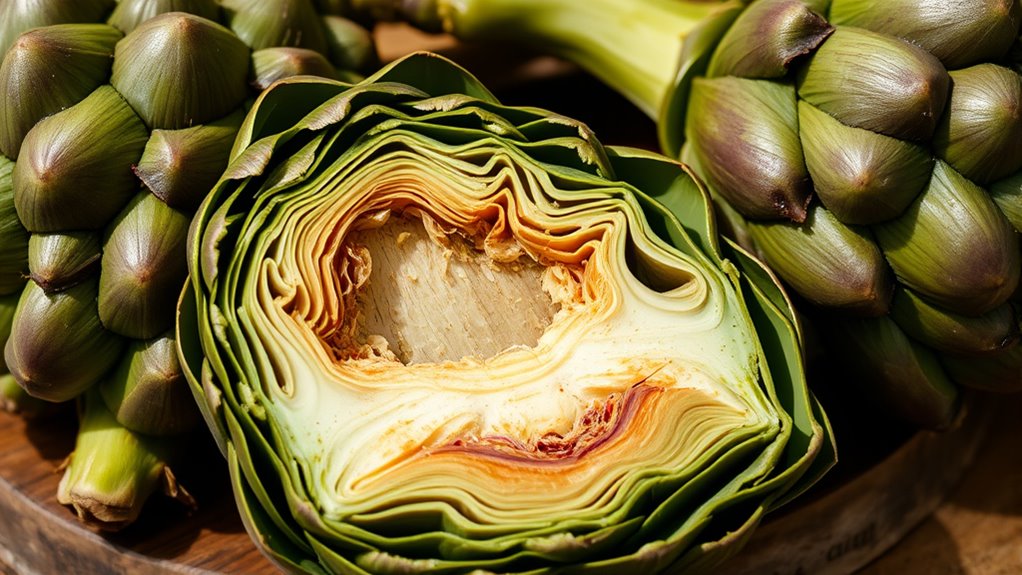
When selecting artichokes for Sardinian dishes, it’s essential to look for the distinctive Spinoso sardo variety, characterized by its conical shape and green leaves with brown-violet nuances. This variety is known for its quality and unique flavor, which results from specific cultivation methods and Sardinia’s microclimate. Confirm the artichoke’s head feels firm and heavy, indicating freshness. The leaves should be tightly closed and vibrant, with no signs of discoloration or wilting. Since they are prickly, handling may require gloves to avoid injury. Look for artichokes that meet PDO standards, affirming proper harvesting and cultivation. The PDO status guarantees the authenticity and quality of the product, Proper selection sets the foundation for the best flavor and texture in your Sardinian recipes. Once chosen, prepare the artichokes by trimming and removing prickly parts before cooking.
Crafting the Classic Sardinian Artichoke Salad (Insalata Di Carciofi)

Crafting the classic Sardinian artichoke salad (Insalata di Carciofi) begins with preparing the freshest, thinly shaved artichokes to maximize flavor and nutrition. Keep them in lemon water or dress immediately to prevent browning and preserve their vibrant color. Incorporate additional raw vegetables like fennel bulb, spinach leaves, radicchio, and wild arugula for texture and flavor complexity. Drizzle with a simple emulsion of high-quality extra virgin olive oil and fresh lemon juice, lightly seasoned with salt. Thinly grate or slice bottarga over the top to add savory depth and a gourmet touch. Gently toss the ingredients just before serving to maintain freshness and crispness. Using fresh, seasonal ingredients ensures the best flavor and nutritional value. Choosing the right types of artichokes can significantly enhance the dish’s authenticity and taste. Optionally, garnish with toasted pine nuts or shaved Parmigiano Reggiano for added nutty and cheesy notes, though these are less traditional.
Making Sardinian Pasta With Artichokes and Fregola
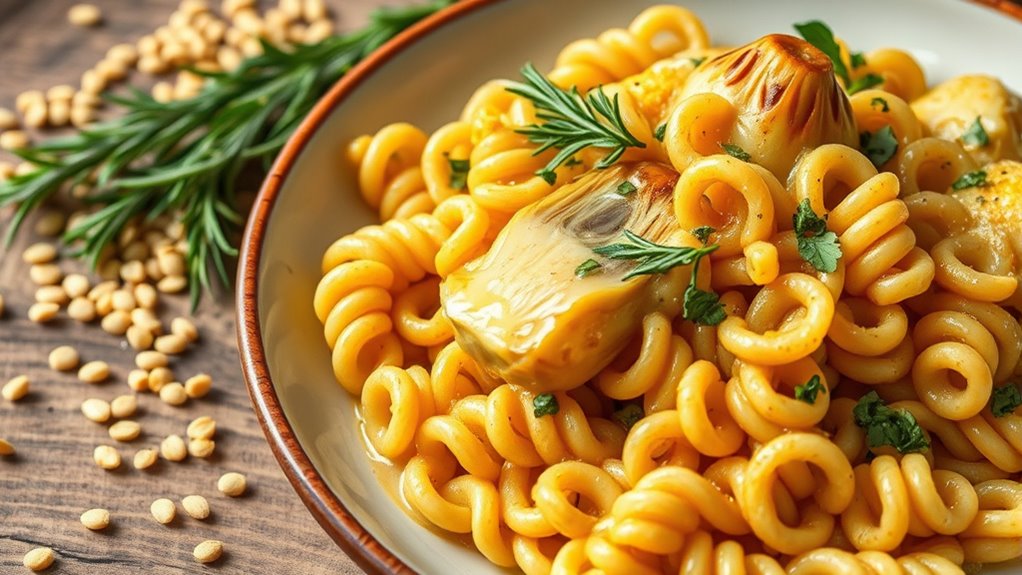
To make authentic Sardinian pasta with artichokes and fregola, start by selecting high-quality fregola, ideally toasted and made from durum wheat. Pay close attention to cooking the pasta slowly in broth, ensuring it absorbs flavors fully and reaches the perfect creamy texture. Layering flavors with sautéed artichokes, wine, and herbs elevates the dish, so don’t rush the process. Using a rich homemade broth can significantly enhance the depth of flavor in the final dish. Incorporating traditional Sardinian ingredients can further bring authenticity and depth to your recipe.
Selecting Authentic Fregola
Choosing authentic fregola begins with inspecting its appearance and ingredients. Look for fregola with a toasted, golden hue and a slightly rough surface—these signs indicate traditional hand-rolling and proper toasting, essential for authentic flavor. The pasta should be made from 100% durum wheat semolina and water, with no added preservatives or additives. Authentic fregola typically comes in small or large sizes; the small variety is versatile for salads and seafood dishes, while the larger works well in soups and stews. Feel the texture—it’s usually crunchy on the outside with a soft interior, a result of the traditional air-drying process. These qualities ensure you’re selecting a product that honors Sardinian culinary heritage and delivers the genuine taste and texture needed for your artichoke dishes. The texture is crunchy outside and soft inside, achieved through this technique. Additionally, choosing fregola with authentic production methods guarantees the best flavor and adherence to traditional Sardinian recipes.
Cooking Pasta Properly
Once you’ve selected the right fregola, it’s time to cook it properly to achieve that authentic Sardinian texture. To do this, use the risottata method: cook the fregola slowly in broth, adding hot liquid little by little, while stirring regularly. Toast the fregola briefly in the pan after sautéing vegetables and aromatics, then gradually incorporate broth until the pasta is tender but slightly chewy—about 8 to 12 minutes. This creates a creamy, porridge-like consistency that melds beautifully with artichokes and sauce. Fregola is best cooked in broth, similar to risotto, for optimal flavor and texture. – Toast fregola after sautéing aromatics for added flavor – Add hot broth gradually, stirring constantly – Cook until tender but slightly chewy for authentic texture – Incorporate cooking techniques to enhance the dish’s depth and authenticity
Enhancing Flavor Layers
Enhancing flavor layers in Sardinian pasta with artichokes and fregola involves carefully building depth through strategic ingredient choices and cooking techniques. Start by sautéing garlic, chili, sun-dried tomatoes, and parsley to create an aromatic base. Deglazing with white wine adds acidity and enriches the dish’s complexity. Use high-quality extra virgin olive oil to boost richness and carry delicate flavors. Incorporate saffron stems during cooking to introduce floral and earthy nuances that complement the artichokes. Gradually add broth or hot water, mimicking risotto, to allow fregola to absorb flavors fully, resulting in a creamy yet firm texture. Finish with chopped parsley and a sprinkle of bottarga for herbal brightness and umami. These steps deepen the dish’s flavor layers and create a harmonious balance. Proper seasoning and careful timing are essential to ensure each layer develops fully and enhances the overall dish.
Assembling the Rustic Panada Di Carciofi (Artichoke Pie)
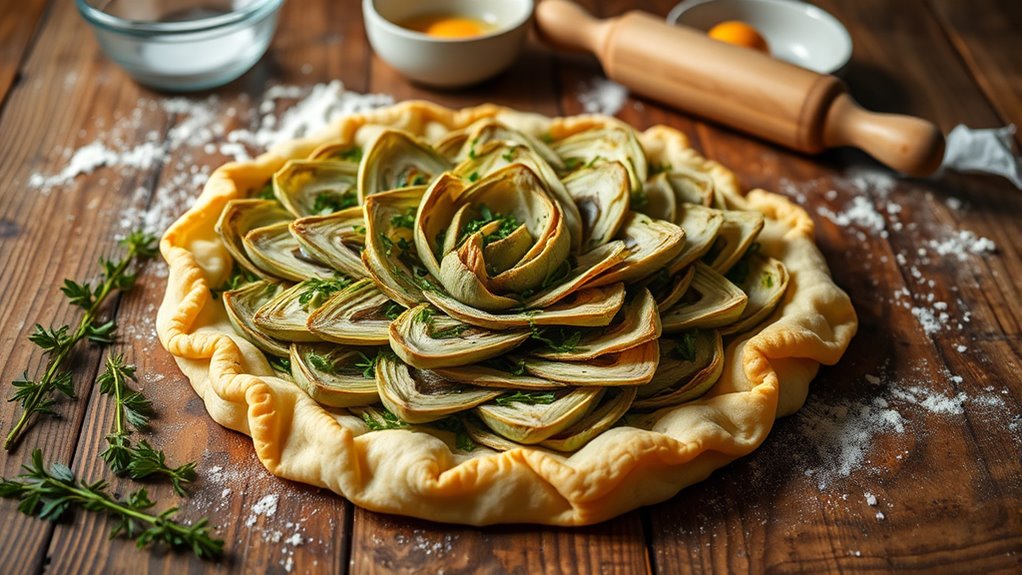
To assemble the Rustic Panada di Carciofi, start by rolling out your prepared dough into two even circles, guaranteeing they’re about the same thickness for uniform baking. Place the filling onto the bottom crust, spreading it evenly without overfilling to prevent rupture. Cover with the second dough circle and seal the edges by crimping or folding for a rustic look. Lightly pierce the top crust with a fork to allow steam to escape, avoiding sogginess. Ensure the filling is centered for balanced baking. When sealing, press firmly to prevent leaks during baking. Once assembled, transfer the pie to a baking sheet lined with parchment paper. Bake in a preheated oven until the crust turns golden brown and the filling bubbles through the vents, about 40-50 minutes.
Start by rolling out two even dough circles, fill, seal, vent, and bake until golden.
- Roll out dough evenly into two circles
- Spread filling without overfilling
- Seal edges and pierce crust for venting
Essential Ingredients and Flavor Enhancers in Sardinian Artichoke Recipes
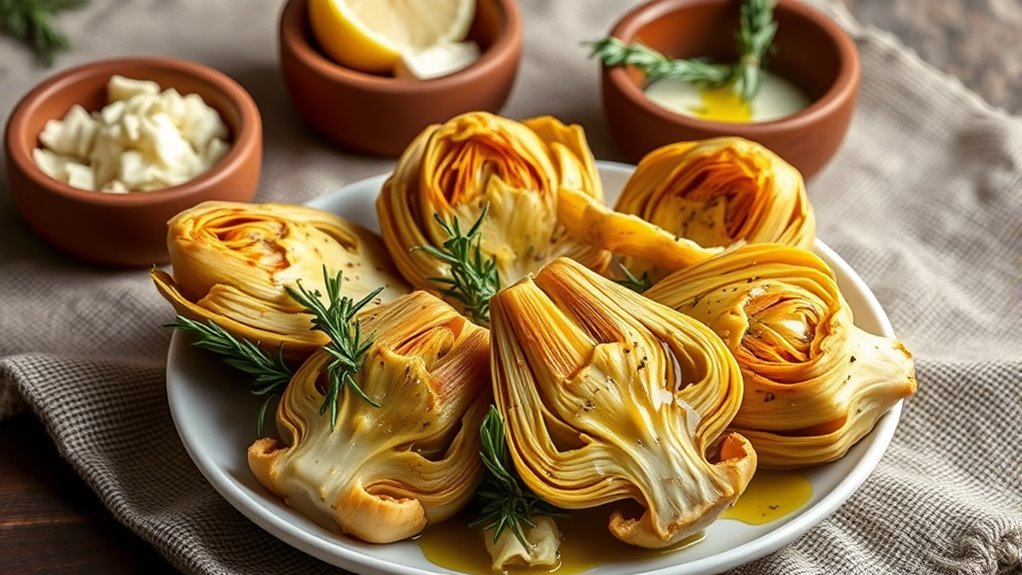
In Sardinian artichoke recipes, a few key ingredients elevate the dish’s flavor and authenticity. Extra virgin olive oil is fundamental, used for sautéing and dressing, bringing a fruity richness and health benefits. It also carries garlic, herbs, and lemon flavors, blending them seamlessly with the artichokes. Fresh lemon juice is essential for brightening dishes, preventing oxidation, and tenderizing in stews or sauces. Sardinian lemons add a vibrant acidity that enhances natural flavors. Aromatic herbs like parsley and mint offer fresh, herbaceous notes, while fennel and onion deepen the savory profile. Dairy and umami boosters, such as pecorino cheese and bottarga, add richness and saltiness, balancing acidity and bitterness. The use of regional ingredients is crucial to achieving the best flavor and authentic regional character in your recipes. These ingredients define the authentic taste and depth of Sardinian artichoke dishes.
Tools and Techniques for Authentic Artichoke Preparation
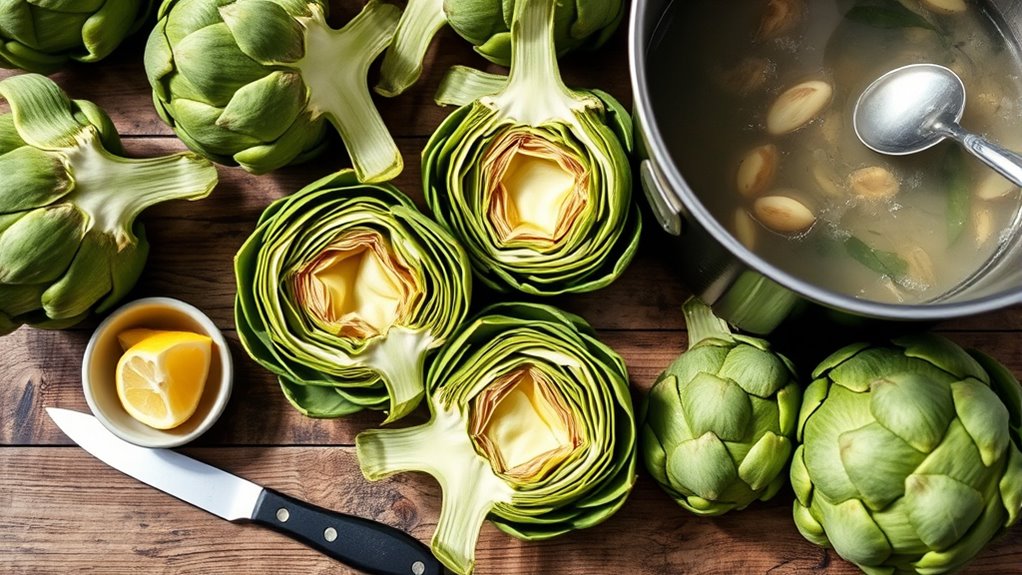
To prepare artichokes authentically, you need the right tools and proper techniques. Using a sharp knife or vegetable peeler helps you cut and trim them cleanly, while the right equipment ensures even slicing and cooking. Mastering these methods makes a big difference in achieving tender, flavorful results. Additionally, understanding seasonal variations can help you select the best artichokes for your recipes.
Proper Cutting Methods
Properly preparing artichokes begins with selecting the right tools and applying precise techniques. You’ll need a sharp chef’s or paring knife, a swivel peeler, and a small spoon or melon baller for effective trimming and cutting. Start by trimming the stem, leaving about 2-3 cm, and peel away tough outer layers with the swivel peeler until lighter flesh appears. Remove dark green or fibrous parts with a paring knife, and rub cut surfaces with lemon juice to prevent browning. Next, peel away outer petals by hand until reaching softer, lighter ones. Cut off the top third of the artichoke for easier handling, and scoop out the fuzzy choke with a small spoon. Always cut on a stable surface and consider gloves for safety. Using the proper tools ensures precise cuts and reduces the risk of injury, which is essential for achieving the desired presentation and ease of cooking. Additionally, understanding industry trends can help you stay updated on the best techniques and equipment for artichoke preparation.
Slicing and Shaving Techniques
After trimming and removing the choke, the next step is to prepare the artichokes for slicing or shaving. Use a sharp paring knife or swivel peeler to peel the stem and base, revealing lighter flesh. For thin, even slices of hearts and petals, employ a mandoline slicer or a very sharp chef’s knife—ideal for salads or sautés. To remove the fuzzy choke inside halved artichokes, use a small spoon or melon baller carefully. Peel fibrous outer stems with a vegetable peeler before slicing them thinly for dishes. To prevent browning, soak slices in lemon juice mixed with water immediately after cutting. Keep your motions smooth and consistent to avoid jagged edges that bruise or brown quickly, maintaining the artichokes’ fresh appearance.
Suitable Cooking Equipment
Choosing the right equipment is essential for authentic Sardinian artichoke preparations. Proper tools guarantee even cooking, preserve flavors, and maintain the dish’s traditional integrity. A deep-frying pan or skillet is perfect for sautéing artichokes with garlic and leeks, creating rich flavors. Large mixing bowls are useful for soaking slices in lemon water to prevent discoloration before cooking or serving raw. An ovenproof pie dish enables even baking of Sardinian artichoke pies (panada), ensuring a crisp crust and fully cooked filling. Additionally, a large pot is necessary for boiling or stewing artichokes in risottos or stews. Using the right equipment, combined with precise techniques, helps you achieve authentic textures and flavors in Sardinian artichoke dishes.
Frequently Asked Questions
Can I Substitute Globe Artichokes for Sardinian Spiny Varieties?
You can substitute globe artichokes for Sardinian spiny varieties, but keep in mind they differ in taste and texture. Globe artichokes are milder and tougher, so you’ll need to adjust cooking time and preparation. Trim their thicker leaves carefully, and consider adding a touch of sweetness or seasoning to mimic the natural flavor of Sardinian spiny artichokes. This substitution works, but it may change the authentic flavor profile of your dish.
What Are the Best Ways to Preserve Artichokes for Sardinian Recipes?
When considering how to preserve artichokes for Sardinian recipes, you’ll find that gentle methods like oil immersion and pickling bring out their best flavors. You can preserve them by blanching, then submerging in quality olive oil or vinegar solutions, ensuring long-lasting freshness. Hand-processing with natural herbs enhances taste, while sterilized jars and cool storage protect their delicate qualities. These techniques let you enjoy authentic Sardinian flavors anytime, with minimal fuss and maximum flavor.
How Do I Prevent Artichokes From Browning in Salads?
To prevent artichokes from browning in salads, you should immediately immerse cut pieces in acidulated water with lemon juice or rub them with lemon halves. Keep the artichokes submerged or covered with airtight wraps, and handle with non-reactive tools. After preparation, pat them dry to avoid diluting dressings. Using stainless steel utensils and storing in the fridge also help preserve their fresh appearance and color longer.
Are Canned or Frozen Artichokes Authentic in Sardinian Dishes?
You might wonder if canned or frozen artichokes are authentic in Sardinian dishes. In traditional Sardinian cuisine, fresh artichokes are preferred because they reflect local farming and preserve the authentic flavors and textures. Canned or frozen varieties are rarely used in genuine recipes, as they don’t match the freshness and seasonality that define Sardinian culinary heritage. Using fresh artichokes keeps your dish true to regional traditions.
What Are Traditional Toppings or Garnishes for Sardinian Artichoke Dishes?
You’ll notice that traditional Sardinian artichoke dishes often feature toppings like Pecorino cheese for a salty kick, fresh parsley or mint to add brightness, and lemon juice to enhance flavors and prevent browning. Drizzle with extra virgin olive oil for richness, and add garlic for depth. These garnishes complement the earthy artichokes, creating a balanced, flavorful dish that’s authentic and simple to prepare.
Conclusion
Now that you know how to select, prepare, and cook with artichokes in Sardinian style, you’ll bring authentic flavors to your kitchen. Imagine the aroma of fresh artichokes mingling with herbs, filling your home with inviting warmth. Why not embrace these vibrant recipes and create dishes that transport you straight to Sardinia’s sun-drenched coasts? With a little practice, you’ll master these methods and impress everyone with your culinary journey. Ready to let your taste buds wander?
